October 25, 2010 – 07:05 am EDT
It was all quiet on the range over the last week with no major moves in either direction. Because there has been such a lack of volume behind the second half of this rally, momentum is particularly important. When the momentum is gone there will be little to hold this market up so any loss of support is likely to escalate into more sustained selling. Indications are that momentum has run out but we are yet to see support levels being broken. Lets take a closer look…
****Thanks to all those who referred people to this newsletter over the last week. The more readers we have the more services we can provide you.
.
ETF % Change Comparison
.

All the influential ETFs managed to finish the week higher but not by much. If we see some profit taking over the coming week I will be looking to IWM and SMH in particular to get a gauge of how real it is.
Learn more – ETF % Change Comparison
.
![]()
.
A Look at the Charts
.
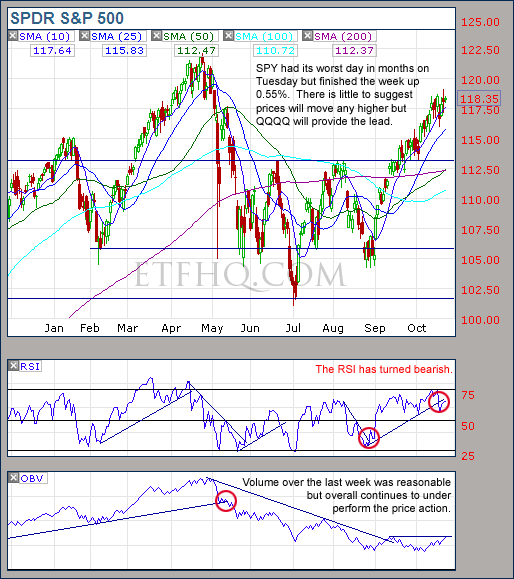
Signs of a slow in momentum on the back of poor volume flows make higher prices difficult.
.
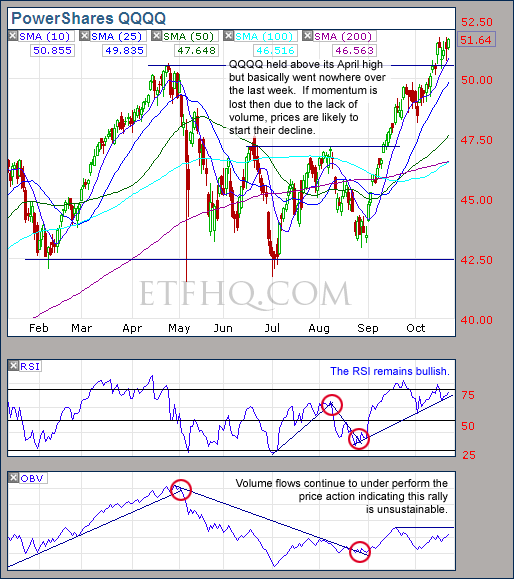
If the RSI on QQQQ turns bearish then this will be a good excuse to take profits as volume flows remain weak.
.
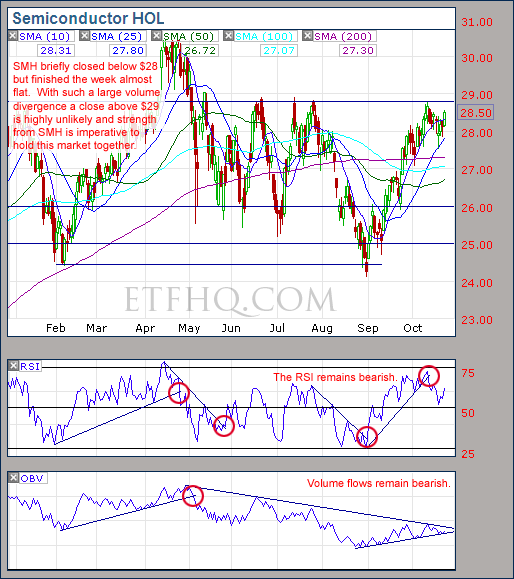
If SMH can close above $29 then I will be very surprised but this would very positive.
.
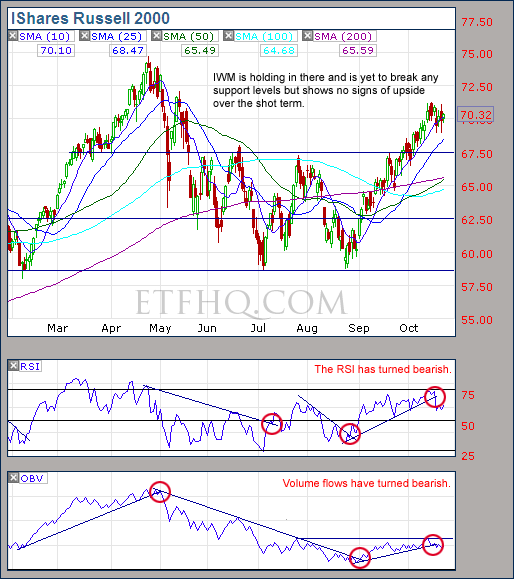
The volume trend has turned bearish along with the RSI indicating that higher prices are most unlikely.
.
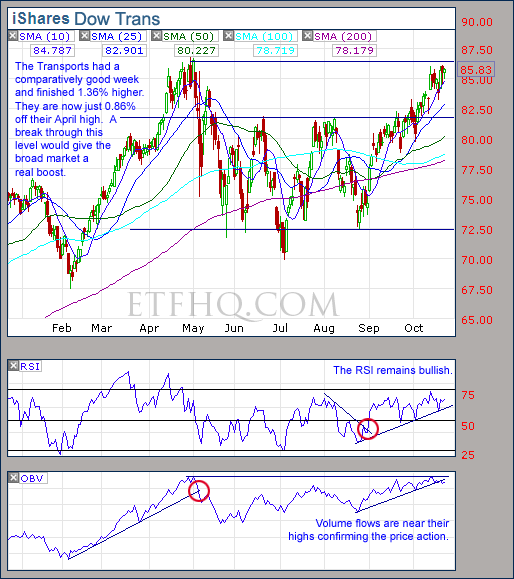
If the transports can close at a new high then this would be a very positive sign for the broad market and would stand as a good reason to keep holding onto your longs.
.
![]()
.
OM3 Weekly Indicator
.

The OM3 indicator remains positive across the board.
Learn more – The OM3 Indicator
.
![]()
TransDow & NasDow
.

The TransDow continues to hold a position (with a small profit) in the Transportation Index as it remains dominant over the Dow. The NasDow indicates that the Dow is dominant over the NASDAQ which is historically an unproductive time so it remains in cash.
.
What the TransDow Readings tell us:
The TransDow measures dominance between the DJ Transportation Index (DJTI) and the Dow Jones Industrial Average (DJIA). In a strong market the more economically sensitive Transportation Index should be dominant over the DJIA.
Historically the DJTI has been dominant over the Dow 45% of the time. The annualized rate of return from the DJTI during this period was 18.47% with the biggest loss for one trade sitting at -13.27%. The annualized return from the DJIA during the periods it was dominant over the DJTI was just 4.06% and the biggest loss for one trade was -16.13%. A 4% stop-loss is applied to all trades adjusting positions only at the end of the week.
What the NasDow Readings tell us:
The NasDow measures dominance between the NASDAQ and the DJIA. Using the same theory behind the Trans Dow; in a strong market the more economically sensitive NASDAQ should be dominant over the DJIA.
Historically the NASDAQ has been dominant over the DJIA 44% of the time. Taking only the trades when the NASDAQ is above its 40 week moving average the annualized rate of return was 25.47% with the biggest loss for one trade sitting at –8.59%. The annualized rate on the DJIA during the periods it was dominant over the NASDAQ is just 8.88% and the biggest loss for one trade was –12.28%. A 8% stop-loss is applied to all trades adjusting positions only at the end of the week.
.
![]()
.
LTMF 80 & Liquid Q
.
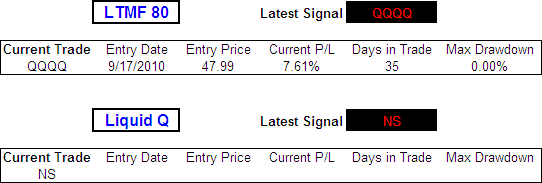
LTMF 80 remains in QQQQ and is showing a tasty little profit while Liquid Q remains in cash.
.
Historical Stats:
.

.
How The LTMF 80 Works
LTMF stands for Long Term Market Forecaster. It reads volume flows relative to price action and looks for out performance of volume measured on a percentage basis over the prior 12 months. During a sustained rally the readings will reach high levels (near 100%) making it imposable for the volume reading to always outperform price so any reading above 80% will maintain the buy signal. This system has outperformed the market over the last 10 years but performance has been damaged by some nasty losses. It only produces buy signals and only for QQQQ.
How Liquid Q Works
Liquid Q completely ignores price action and instead measures the relative flow of money between a selection of economically sensitive and comparatively stable ares of the market. It looks for times when the smart money is confident and and can be seen by through volume investing heavily is more risky areas due to an expectation of expansion. This system has outperformed the market over the last 10 years and remained in cash through most of the major declines. It only produces buy signals and only for QQQQ. We will provide more performance details on the web site for these systems soon.
.
![]()
.
Summary
The Transports are knocking on the door of new highs and SMH on the door of a higher high. The market is unlikely to have the momentum to break through these resistance levels but if it can then profit taking can occur without killing the bull. If the profit taking comes before these levels are broken then due to the lack of volume the declines could be sharp.
.
Any disputes, questions, queries, comments or theories are most welcome in the comments section below.
.
Cheers
Derry
And the Team @ ETF HQ
“Equipping you to win on Wall St so that you can reach your financial goals.”
.
P.S Like ETFHQ on Facebook – HERE
.
![]()
.
Quote of the Day:
“It doesn’t matter if people are interested. It’s about you taking your stuff and shouting out into the void.” – Jadelr and Cristina Cordova
For months, you have been pointing out the “lack of volume” in the market. Yet, it keeps on grinding upwards day-after-day. For example, despite a lower opening this morning, the market is now positive. Would past market history provide any clues on why? Any other comments?
You are very right in this observation. Volume is important but at the end of the day price is what matters. I picked up the start of the rally and missed the middle due to not trusting the lack of volume behind the move.
Looking for historical examples; there were warning signs for 3 months before they actually occurred in 2008. In that case they more came from a price divergence than lack of volume – http://etfhq.com/comparison.gif
But if you have a look at OBV on SMH in late 2007 you will see that it was also very much under performing the price. In my trading I do my best to act upon what I see while waiting for confirmation from the price action. At the moment I see high risk but for the time being prices as you say continue to grind higher. IYT and SMH are right up against resistance, it will be interesting to see if they can break through.
Thanks for your question
Cheers
Derry